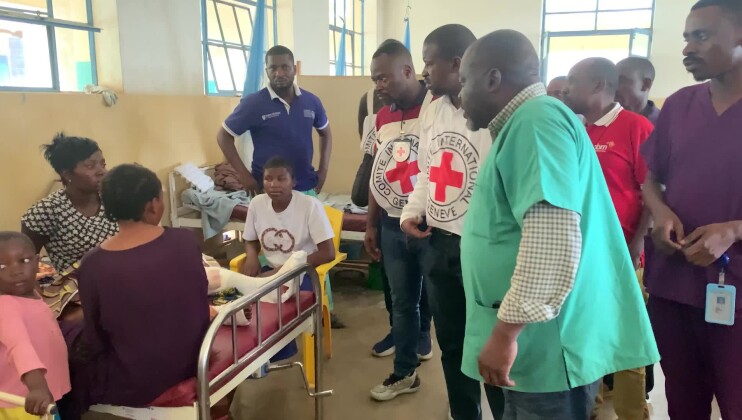International Mine Awareness Day: Casualties surge from landmines and unexploded ordnance
In 2024, casualties from landmines and unexploded ordnance surged by 22% (Landmine Monitor 2024). Figures the ICRC have gathered from early 2025 indicate that the rise in victims will further intensify this year. From Ethiopia to Iraq, from Syria, to Ukraine and Afghanistan, landmines and unexploded ordinance are a leading cause of civilian casualties in war. Over 80% of anti-personnel mine victims are civilians, many children.
Ahead of the International Day for Mine Awareness and Assistance in Mine Action (April 4), we remind all warring parties of the appalling impacts of these weapons and their obligations under the laws of war, international humanitarian law (IHL), to limit suffering in war.
In Ukraine, husband and wife Vasyl and Tetiana are both trying to live with their injuries from mines in Kamianka village, Izium district, Kharkiv region, Ukraine. “On 4th June, I went with my son to the river to cut some green grass for our cow,” explains Tetiana. “And just as I started raking, there was an explosion. Earth was falling on top of me. I turned over, knelt down and started crawling towards the car. I crawled to the car, he (my son) was shouting: ‘Mum, don't crawl, I'll carry you. We came home just as my younger son and his family arrived, because the day when it happened, 4 June, was my birthday.”
Vasyl and Tetiana are two of the many people in the Kharkiv region who needed prosthetics following mine blast injuries. The International Committee of the Red Cross, beyond supporting displaced people with food and basic supplies, is the only organisation providing physical rehabilitation services for people with major lower limb amputations in the eastern part of Ukraine.
Tabir Gebreyohannes’ eight-year-old daughter was injured after stepping on an unexploded device in Ethiopia. Heavy fighting in the northover the past years means millions of people live and work in areas with a heavy presence of unexploded ordnance. "I was in church when the accident happened,” Gebreyohannes recalls. “I hurried home as soon as I heard the blast. She was unconscious. When she walks (now), I would say she has a disability. Her one leg lags whenever she walks. She is afraid. She is traumatized by what happened.”
Children make up 80% of the patients at the International Committee of the Red Cross (ICRC) physical rehabilitation program in Tigray, Ethiopia. Death and injury are just one element of the suffering. The weapon contamination seriously affects food production and there are high malnutrition rates, especially among new mothers and children under the age of five. The ICRC, together with Ethiopian Red Cross Society, is working with communities to raise awareness and reduce the risk. The ICRC is also urging the authorities to proceed with clearance work, a task of tremendous costs and proportions, especially in places where conflicts are still ongoing.
In Syria, in the first three months of this year alone, at least 500 casualties have been recorded due to explosive ordnance. In 2024, the ICRC recorded 388 explosive ordnance accidents, resulting in over 900 casualties, with more than 380 fatalities. One-third of the victims were children. Cooperating with the Syrian Arab Red Crescent to map the risks, the ICRC has cleared over 737,000m2 and safely destroyed 559 explosive devices. This has helped an estimated 93,500 people regain access to their homes and livelihoods.
In Iraq, landmines and explosive remnants of war (ERW) contaminate an estimated 2,100 km² of land in Iraq— equal to 300,000 football fields. Download our latest footage here from Iraq (2 April 2025) on the long shadow these weapons cast.
ICRC’s weapon contamination expert Erik Tollefsen knows from first-hand experience about the hidden dangers: “Landmines and unexploded ordnance are difficult to see and stepping on them or the slightest touch can bring them to explode,” explains Tollefsen. “Such explosive remnants of war do not differentiate between civilians or soldiers, children and adults. The increased use of improvised explosive devices, shifting frontlines, and deteriorating security will make survey and clearance efforts more complex, leaving communities increasingly vulnerable. Such weapons do not only cause harm and human suffering, it also brings additional toll to existing health structures and staff that are already overstretched.”
International humanitarian law, the laws of war, exists to limit suffering in the darkest of days, when conflict rages and lives are at risk. Now is the time to strengthen, not weaken, these commitments that all states have signed up to. We call on States to reinforce the stigma against weapons whose human cost is unacceptable. We urge all States to reinforce, not erode, frameworks that protect civilians in conflict.
ICRC action on weapon contamination
The ICRC strengthens local capacity to address weapon contamination risks and assist survivors by supporting National Red Cross and Red Crescent Societies, mine-action authorities, civil defense teams, and health ministries. We provide technical expertise, training, and mentoring for mine-action personnel, first responders, and rehabilitation specialists. We also help authorities and National Societies run localized risk education programs. Additionally, we support national health institutions by training prosthetists, physiotherapists, and mental health specialists. Through advocacy, we engage national authorities to strengthen adherence to international humanitarian law, pushing for policies that protect civilians and prioritize victim assistance and humanitarian demining.
SHOTLIST
Length: 09:42
Copyright: ICRC access all
On Screen Credit: ICRC written or logo
Location: Rural Damascus, Syria
Date: 06.08.2024
0 – 1:28 Various of safe disposal unexploded remnants of war by ICRC
Location: ICRC, Geneva, Switzerland
Date: 02.04.2024
1:28 SOUNDBITE Erik Tollefsen, Weapon Contamination Expert, ICRC (in English):
“Landmines and unexploded ordnance are difficult to see and stepping on them or the slightest touch can bring them to explode. Such explosive remnants of war do not differentiate between civilians or soldiers or children and adults. In 2024, casualties from weapon contamination surged by 22%, with the majority being civilians. Figures the ICRC have gathered from early 2025 indicates that the rise in victims will intensify further this year. The increased use of improvised explosive devices, shifting frontlines, and deteriorating security will make survey and clearance efforts more complex, leaving communities increasingly vulnerable. Such weapons do not only cause harm and human suffering. It also brings additional toll to existing health structures and staff that are already overstretched.”
Location: Kamianka village, Izium district, Kharkiv region,
Date: 11/03/2025
Camera & editor: Anna Bilous
2:42 Various shots of husband and wife Vasyl and Tetiana who were injured in the home in Kamianka village, Izium district, Kharkiv region
SOUNDBITE Tetiana at the Prosthetic and Orthotics Laboratory of the ICRC and Kharkiv University Clinic (in Ukranian):
3:34 He [my husband was injured] in 2022, and I, in 2024.
3:39 On 4 June, I went with my son to the river to cut some green grass for our cow.
My son was cutting it and I was following him with a rake to gather everything in a pile.
3:45 And just as I started raking, there was an explosion. At first, I did not understand what had happened. I was thrown and fell. Earth was falling on top of me. My son immediately bandaged my leg above the knee. I turned over, knelt down and started crawling towards the car. I crawled to the car, he was shouting: ‘Mum, don't crawl, I'll carry you,’ We came home just as my younger son and his family arrived, because the day when it happened, 4 June, was my birthday.
5:26 Various shots of Tetiana’s husband being cared for at the Prosthetic and Orthotics Laboratory of the ICRC and Kharkiv University Clinic.
Location: Tigray region, Ethiopia,
Date Of Filming: 02.09.2024 – 06.09.2024
Language: English, Tigrinya
Producer: Alyona Synenko
Video Cameraperson: Chris Sang
5:48 Unexploded ordnance (UXO) lodged in a road with ICRC vehicles in the background and ICRC weapon contamination (WEC) specialist inspecting UXO and taking notes.
6:08 Various of ICRC vehicles enroute to Newi.
6:40 people walking on a road in Newi and UXOs
7:03 Tabir Gebreyohannes and her Children walking home in Newi.
SOUNDBITE: Tabir Gebreyohannes, whose daughter was a UXO victim
7:18 “I was in church when the accident happened. I hurried home as soon as I heard the blast. The people who were there bandaged her. She was unconscious. When she walks, I would say she has a disability. Her one leg lags whenever she walks. She is afraid. She is traumatized by what happened. When she walks around, she does not go far. The metals (referring to the unexploded ordnance) are not cleared yet. We are afraid to leave the children behind to go to work. The likelihood of them stepping on the explosives is very high.”
8:02 Tabir's daughter who was injured by a UXO
8:08 Close up shot of Tabir in her house.
8:14 Tabir preparing to cook a meal for her family.
8:32 UXOs littered around Newi.
09:00 ICRC WEC delegate and Ethiopia Red Cross Society (ERCS) volunteer putting up a hazard warning sign at a UXO pile location in Newi.
9:15 ICRC WEC team and ERCS Volunteer conducting a risk awareness & safe behavior session with children in Newi.
Iraq
Download our latest footage here from Iraq (2 April 2025) on the long shadow these weapons cast. In Iraq, landmines and explosive remnants of war (ERW) contaminate an estimated 2,100 km² of land in Iraq— equal to 300,000 football fields.



